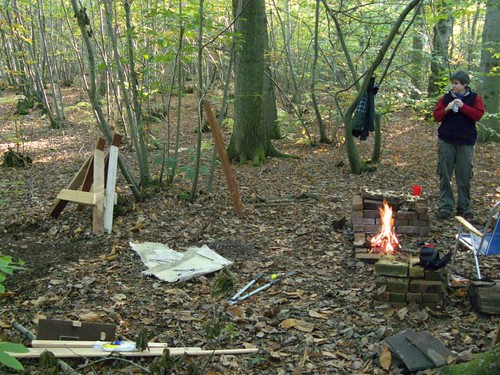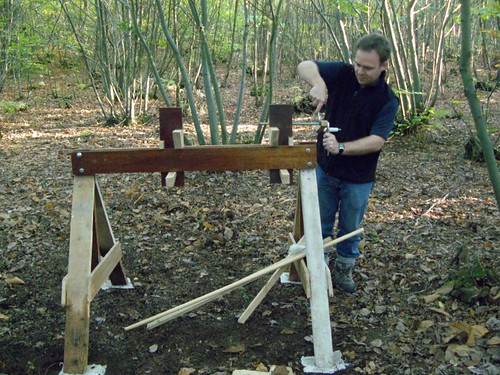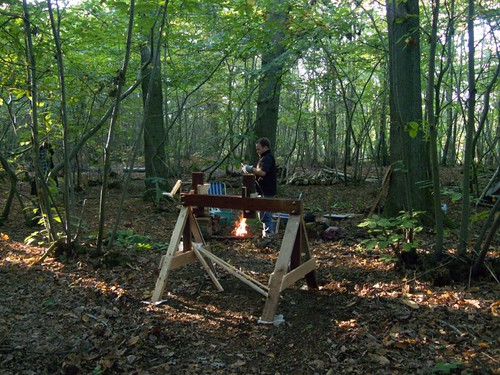IMPORTED POST FROM OLD BLOG. ORIGINAL DATE: 27/10/2007
I've been out on the chainsaw training course all week, and buying equipment, hence the lack of posts to the blog. Here's the details:
- I've done NPTC units 30 and 31. I plan to do the assessment in a few weeks so that if I want to I can get insurance and work on other people's land.
- Even if I wasn't doing the assessment (not everyone on the course is), the training is invaluable. A lot of what we are learning will work just as well with hand saws as it will with chainsaws.
- Unit 30 covers maintenance and cross-cutting. A poorly maintained saw is a dangerous saw, especially if the cutters are not sharp. Sharpening requires a few special tools and some tuition to get it right. It takes a while, but you really notice the difference when you use the saw!
- Unit 31 covers felling trees up to 15" diameter, and you go through the use of several types of felling cuts, as well as using a felling lever, cant hook, turning strap, winch, etc. You also cover efficient methods of working, such as moving logs, stacking them, felling trees on top of eachother to get them of the ground. This last point is key, as it makes snedding (removing the branches) much easier. Even snedding has a special method though - there are 6 permitted cuts, and 2 not permitted. The 2 banned cuts are dangerous, and have resulted in accidents where the chainsaw trousers can be breached!
- We've studied a lot of safety, including why the back of a tree being felled is as dangerous as the front - the tree can split, and the back will kick up hard enough to knock you through the air. Our instructor knew someone who had been killed in this way. Ash is the worst for it, and is known as the "widow maker". Sycamore and chestnut do it too.
- Protective clothing: the minimum is protective boots, trousers, helmet, ear and eye protection. Gloves are useful for handling anyway, but the risk of actually having the saw hit your hand should be close to zero if you use it properly - you are meant to keep two hands on at all times, and apply the chain brake before taking a hand off! A chainsaw jacket is not really needed for work on the ground - they are for tree surgeons. Our instructor had never heard of an upper-body injury happening on the ground in decades. For eye protection goggles are OK, but prone to misting - we all used metal visors. Ear protection is vital for anyone within 5-10m. Having said all this the biggest protection is proper training...
- Some people have mentioned kickback. All the saws we used had a combined manual/inertial chainbrake. We saw this demonstrated by the instructor - as soon as kickback happens the brake applied itself and the chain had stopped dead before it had moved 8-10 inches. However, you obviously try and avoid kickback through proper use of the saw, simply because it is annoying and disrupts your work. Also, checking the chainbrake stops the chain at full throttle is one of the daily safety checks you must perform.
- Finally, choosing a saw... The important thing is to try some out. After the maintenance part of the course I was quite keen on the Stihl 260 as it looked easier to work with. However, having tried it in the wood I went off it, compare to a Husky 242. The Stihl stalls a lot (a common 260 problem according to our instructor), and it also kicks a lot in your hand when you rev it. The Husky ran better, didn't kick on revving, and generally was a better-handling saw. So, I've chosen the Husky 346XP, based on experience and the instructor's advice. It's a pro-quality saw, with a 50cc engine and variable rate oil pump. I got it with a 13" bar, which gives more power and is easier to use for most work. I also got an 18" bar for the odd occasion when I need to tackle something bigger.
- One other point - some people have mentioned "transition" to a sustainable situation - this is exactly what it is about. As long as I'm doing my work for the Ashden Awards I simply don't have the time to work our wood by hand. Having the chainsaw will allow us to get the coppice in rotation and deal with any "problem" trees over the next few years, while still earning a decent wage from another job. If/when the value of wood fuel rises, it will become progressively more viable to work in the wood as our main job, and we'd have the time to do more of it by hand. Even now, we will still be doing a portion of the work by hand - there are a lot of jobs that you can do with the chainsaw, but it's not much quicker than a sharp billhook or loppers.

There's also some other pictures I need to put up - the pole lathe is now in the wood, at last! Here's some pics of its assembly and current location:




Mike

No comments:
Post a Comment